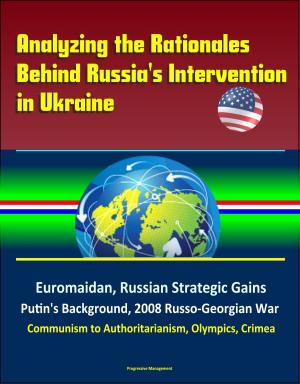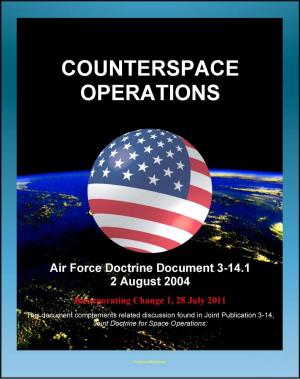21st Century U.S. Military Manuals: Air Force Handbook - Civil Engineer Camouflage, Concealment, and Deception Measures
Nonfiction, History, Military, United States| Author: | Progressive Management | ISBN: | 9781466026155 |
| Publisher: | Progressive Management | Publication: | February 21, 2012 |
| Imprint: | Smashwords Edition | Language: | English |
| Author: | Progressive Management |
| ISBN: | 9781466026155 |
| Publisher: | Progressive Management |
| Publication: | February 21, 2012 |
| Imprint: | Smashwords Edition |
| Language: | English |
Part of our value-added professional format series of U.S. military manuals, this new 2011 U.S. Air Force manual covers camouflage, concealment and deception (CCD) - the use of materials and techniques to hide, blend, disguise, decoy, or disrupt the appearance of military targets and/or their backgrounds. CCD helps prevent an enemy from detecting or identifying friendly troops, equipment, activities, or installations. Properly designed CCD techniques take advantage of the immediate environment and natural and artificial materials.
This handbook is designed to take the reader through the sequential stages of CCD in hopes of understanding and correctly implementing the CCD plan. This understanding begins with knowing the threat you are faced with. Threat familiarization determines the necessity of CCD, and if so, what CCD measures will be effective. The fundamentals of CCD are discussed to give the reader the foundation necessary to effectively execute the CCD plan. Next, the handbook explains how CCD fits in the overall installation's defensive operations plan to blind the enemy. Then, suggestions are given to help determine which assets are high valued targets and how to protect those targets using CCD. Finally, details are given on how the environment may affect CCD implementation measures.
CCD degrades the effectiveness of enemy reconnaissance, surveillance, and target acquisition (RSTA) capabilities. Skilled observers and sophisticated sensors can be defeated by obscuring telltale signs (signatures) of units on the battlefield. Preventing detection impairs enemy efforts to assess friendly operational patterns, functions, and capabilities.
CCD enhances friendly survivability by reducing an enemy's ability to detect, identify, and engage friendly elements. Survivability encompasses all actions taken to conserve personnel, facilities, and supplies from the effects of enemy weapons and actions. Survivability techniques include using physical measures such as fighting and protective positions; chemical, biological, radiological, and nuclear (CBRN) equipment; and armor. These actions include interrelated tactical countermeasures such as dispersion, movement techniques, OPSEC, communications security (COMSEC), CCD, and smoke operations (a form of CCD). Improved survivability from CCD is not restricted to combat operations. Benefits are also derived by denying an enemy the collection of information about friendly forces during peacetime.
Deception helps mask the real intent of primary combat operations and aids in achieving surprise. Deception countermeasures can delay effective enemy reaction by disguising information about friendly intentions, capabilities, objectives, and locations of vulnerable units and facilities. Conversely, intentionally poor CCD can project misleading information about friendly operations. Successful tactical deception depends on stringent OPSEC. As mentioned previously, deception does not fall within CE responsibilities; however, regarding CCD planning and employment, it should be expected that engineers will be tasked to assist in deception operations.
Part of our value-added professional format series of U.S. military manuals, this new 2011 U.S. Air Force manual covers camouflage, concealment and deception (CCD) - the use of materials and techniques to hide, blend, disguise, decoy, or disrupt the appearance of military targets and/or their backgrounds. CCD helps prevent an enemy from detecting or identifying friendly troops, equipment, activities, or installations. Properly designed CCD techniques take advantage of the immediate environment and natural and artificial materials.
This handbook is designed to take the reader through the sequential stages of CCD in hopes of understanding and correctly implementing the CCD plan. This understanding begins with knowing the threat you are faced with. Threat familiarization determines the necessity of CCD, and if so, what CCD measures will be effective. The fundamentals of CCD are discussed to give the reader the foundation necessary to effectively execute the CCD plan. Next, the handbook explains how CCD fits in the overall installation's defensive operations plan to blind the enemy. Then, suggestions are given to help determine which assets are high valued targets and how to protect those targets using CCD. Finally, details are given on how the environment may affect CCD implementation measures.
CCD degrades the effectiveness of enemy reconnaissance, surveillance, and target acquisition (RSTA) capabilities. Skilled observers and sophisticated sensors can be defeated by obscuring telltale signs (signatures) of units on the battlefield. Preventing detection impairs enemy efforts to assess friendly operational patterns, functions, and capabilities.
CCD enhances friendly survivability by reducing an enemy's ability to detect, identify, and engage friendly elements. Survivability encompasses all actions taken to conserve personnel, facilities, and supplies from the effects of enemy weapons and actions. Survivability techniques include using physical measures such as fighting and protective positions; chemical, biological, radiological, and nuclear (CBRN) equipment; and armor. These actions include interrelated tactical countermeasures such as dispersion, movement techniques, OPSEC, communications security (COMSEC), CCD, and smoke operations (a form of CCD). Improved survivability from CCD is not restricted to combat operations. Benefits are also derived by denying an enemy the collection of information about friendly forces during peacetime.
Deception helps mask the real intent of primary combat operations and aids in achieving surprise. Deception countermeasures can delay effective enemy reaction by disguising information about friendly intentions, capabilities, objectives, and locations of vulnerable units and facilities. Conversely, intentionally poor CCD can project misleading information about friendly operations. Successful tactical deception depends on stringent OPSEC. As mentioned previously, deception does not fall within CE responsibilities; however, regarding CCD planning and employment, it should be expected that engineers will be tasked to assist in deception operations.















